Getting to Know Chendra

 Her History Her History  Her Journey Her Journey  Her Future Her Future
Chendra's History
In 1997, the Oregon Zoo announced plans to bring a female elephant from Asia to the United States.
The primary goals for this project were:
- Add diversity to the American Zoo and Aquariums North American Asian Elephant Species Survival Plan.
- The elephant would benefit from our care and the companionship of our elephants.
- The elephant would be a positive addition to the existing elephant group at the Oregon Zoo.
- The country of origin would be willing to work with the Oregon Zoo as a long-term conservation partner.
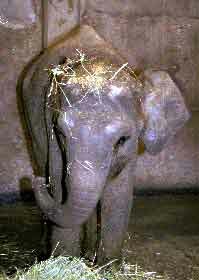 After a year of research, Mike Keele, Oregon Zoo curator and assistant director, traveled to Malaysia in July 1998 accompanied by the zoo education manager. They met with local wildlife officials and conservationists to further discuss the zoos plan. In Malaysia, Keele was introduced to several elephants that officials planned to relocate, as well as five young elephants that, for various reasons, could not be reunited with their herd or returned to their original habitat. After a year of research, Mike Keele, Oregon Zoo curator and assistant director, traveled to Malaysia in July 1998 accompanied by the zoo education manager. They met with local wildlife officials and conservationists to further discuss the zoos plan. In Malaysia, Keele was introduced to several elephants that officials planned to relocate, as well as five young elephants that, for various reasons, could not be reunited with their herd or returned to their original habitat.
One of those elephants was Chendra, a four-year-old female. She and her mother were frightened away from a palm oil plantation in Sabah on the northern part of the island of Borneo. Chendra's front leg was and left eye were wounded. Several days later she was found wandering through the plantation, showing signs of hunger. When her mother did not return, the calf was rescued by wildlife officials. Chendras leg wound was superficial. However her eye was permanently blinded. This, combined with her age, made her a poor candidate for relocation and release to the wild. It was clear that Chendra would always be dependent on humans for her survival.
Chendra's Oregon Zoo family provides her with three female companions. Rose-Tu, the youngest elephant at the zoo, now has a playmate closer to her age.
The Malaysian government has stated that Chendra can benefit from our care and knowledge, and that her move to Portland released resources in Malaysia that could be devoted to another elephant in need. Oregon Zoo and Sabah wildlife officials have developed a long-term conservation partnership to share knowledge and resources that will benefit not only elephants, but other species native to Southeast Asia.
back to top
Friday, Nov.12, 1999
Zookeeper Ray Hopper and PR guy Steve Cohen from the Oregon Zoo left Portland at 10:30 p.m. to begin their long journey to Sabah, Malaysia, on the isle of Borneo. Steve is armed with a special cellular phone, a tiny lap top computer and a digital phone, which he will use to try and send us daily updates.
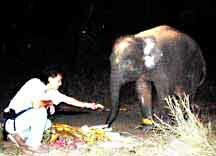
Saturday, Nov. 13, 1999
One sad e-mail from Steve today entitled "No Phone." Steve is still in Kota Kinabalu, Sabah's capitol city. He found a way to connect to the internet from there, but tomorrow he heads into the back country. We're afraid all our technology may be too much for the wilds of Borneo. Knowing Steve, he'll find a way to keep us in touch, or he'll die trying!
Monday, Nov. 15, 1999
Still no word from Steve...
By now, he and Ray should be in Tabin Wildlife Reserve, in Eastern Sabah, where Chendra is waiting.
Tuesday, Nov. 16, 1999
Steve is back in Kota Kinabalu, and has re-established contact. Here's his latest message and a photo:
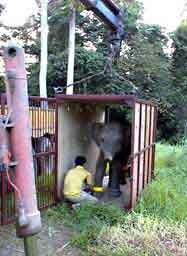 Most everything going well, but very hectic. We hurry-up and wait a lot. Chendra was loaded in her crate yesterday ( Monday) and we left Tabin at 6 p.m. We drove through the night over Mt. Kinabalu and Chendra did very well. The physical move itself, was very anticlimactic. We arrived in Kota Kinabalu this morning around 6 a.m. and drove her to the home of the local shipping agent. We'll go back at 4:30 tomorrow morning and bring her to the airport and she'll fly to Kuala Lumpur. Ray and JB, Chendra's current keeper are exchanging information and JB is looking forward to coming to the US and meeting zookeepers. Didn't have time to seek out other wildlife, but saw many hornbills, pig-tailed macaques and monitors. In Tabin, the night was filled with the sound of bellowing wild elephants. Most everything going well, but very hectic. We hurry-up and wait a lot. Chendra was loaded in her crate yesterday ( Monday) and we left Tabin at 6 p.m. We drove through the night over Mt. Kinabalu and Chendra did very well. The physical move itself, was very anticlimactic. We arrived in Kota Kinabalu this morning around 6 a.m. and drove her to the home of the local shipping agent. We'll go back at 4:30 tomorrow morning and bring her to the airport and she'll fly to Kuala Lumpur. Ray and JB, Chendra's current keeper are exchanging information and JB is looking forward to coming to the US and meeting zookeepers. Didn't have time to seek out other wildlife, but saw many hornbills, pig-tailed macaques and monitors. In Tabin, the night was filled with the sound of bellowing wild elephants.
Wednesday, Nov. 17, 1999
The latest from Steve:
This morning we were still in Kota Kinabalu and Chendra was put back in her crate at 4 a.m.and driven to the airport for her journey today to Kuala Lumpur. Ray and I were on a different flight than Chendra. Hers was supposed to have left earlier than ours, but it was delayed and we arrived before she did.
The animal "hotel," which was designed for horses is part of the huge, new Kuala Lumpur airport . Ray and JB took Chendra out for a walk in the exercise yard, gave her a bath and brought her back in to feed her. She's very fond of yams and sugar cane. There was some local confusion about what is hay and what is straw, but it definitely was straw that was delivered from the Kuala Lumpur Zoo. They say that is what they use to feed their animals.
She seems to be doing very well. Nervous, of course, but everything is new to her -- sights, smells, noises. Ray and JB will go back and check on her frequently. We do have a layover here of over 30 hours.
Right now, the rain is torrential and the lightning is spectacular.
Friday, Nov.19, 1999
Chendra and her entourage flew today from Kuala Lumpur to San Francisco, via Seoul, South Korea and Anchorage, Alaska. In San Francisco, Chendra was greeted with fresh hay and was loaded onto a truck which headed for Portland.
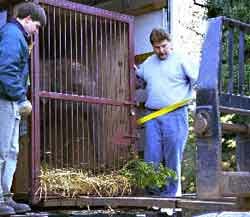 Saturday, Nov. 20, 1999 Saturday, Nov. 20, 1999
Chendra and crew arrived at the zoo about 10:45 a.m. As a crowd of reporters, photographers and zoo and Enron staff watched, Chendra's crate was carefully forklifted off the back of the truck and set down behind the elephant barn, while another, smaller forklift was maneuvered into place. As Chendra swung her trunk back and forth with nervous anticipation, elephants in the nearby "front yard" stuck their trunks under the fence to better smell the newcomer.
Chendra's crate was then forklifted to the door of a suite where she will spend six weeks of quarantine before going on exhibit. Chendra was let out into her new quarters, and spent the next hour conversing with the zoo's other elephants.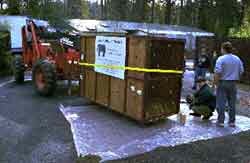
Sunday, Nov. 21, 1999
Things are quieter in the Elephant barn today. The USDA inspector paid Chendra a visit, and everything went well. Then the zoo's maintenance staff made a bonfire of the leftover bedding and food from Chendra's crate, to make sure insects or seeds from Malaysia don't spread into Oregon.
Monday, Nov.22, 1999
Chendra has settled in nicely. Keeper Ray Hopper says she is eating everything they give her, and is enjoying a gift of mangos, papayas and yams delivered by Pacific Coast Fruit company. Ray and Steve are recuperating from their trip.
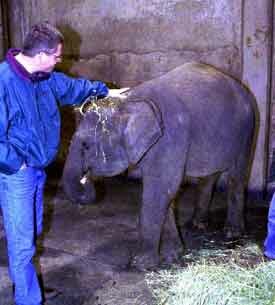
Friday, Dec. 31, 1999
Chendra is getting along just fine and the vet has released her from quarantine. Keepers are slowly introducing her to her new world and the other elephants. If all goes well, she will be on public view in late January or early February. A big party is planned for her debut.
back to top
The zoos hope that Chendra, who spent three years as a solitary elephant, would become an integrated member of the Oregon Zoos female social group quickly became a reality.
Elephants are social animals and benefit from being in a group where the age structure includes older and younger animals. Younger animals in these social groups have the opportunity to learn mothering skills which may help prepare them to care for their own calves. Providing a beneficial social environment for Chendra gives the Oregon Zoos elephants a much needed companion, and the ability to work toward the goal of increasing the genetic diversity of the overall North American population of Asian elephants.
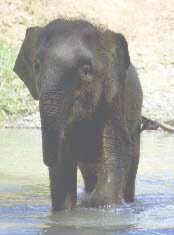
The survival of the elephant is a global problem. In his book Gone Astray, the Care and Management of the Asian Elephant in Domesticity, published in 1997, Richard Lair summarizes the situation for Asian elephants. He says that at this time, there are no self-sustaining captive Asian elephant populations in Asia or any other country. The human population in Asia is expected to double within the next 30 years, which will undoubtedly adversely affect the wild and domesticated populations of elephants.
Bob Wiese, Ph.D., American Zoo and Aquarium's Small Population Management Advisor to the Elephant Species Survival Plan and Assistant Director of Collections at the Fort Worth Zoo, has shown that by the year 2038, the North American elephant population will consist of 22 females over the age of 30 years--all past the prime age of reproduction. Lair notes that the North American population, though better off than the European, is not self-sustaining and would some day be dependent on acquiring breeding elephants from Asia for the purpose of protecting genetic diversity. The possibility of transporting orphaned or captive-bred elephants from Asian countries to foreign zoos has been recognized in the major conservation plans from Asian governments and conservation organizations.
back to top
|


